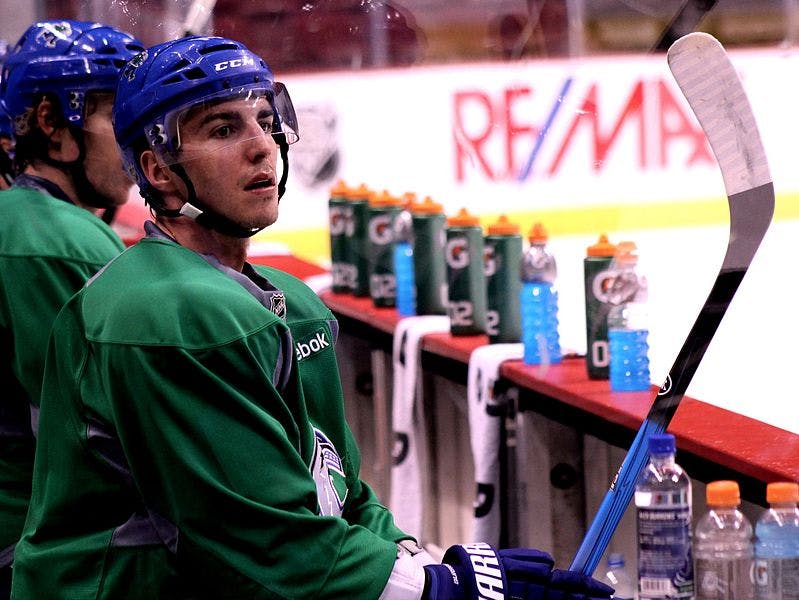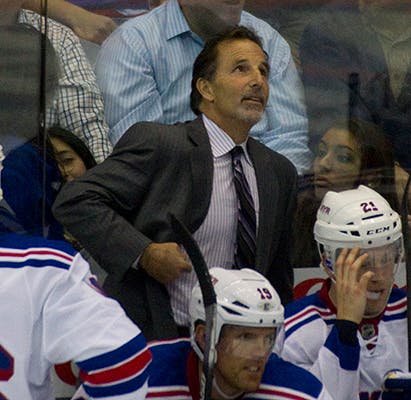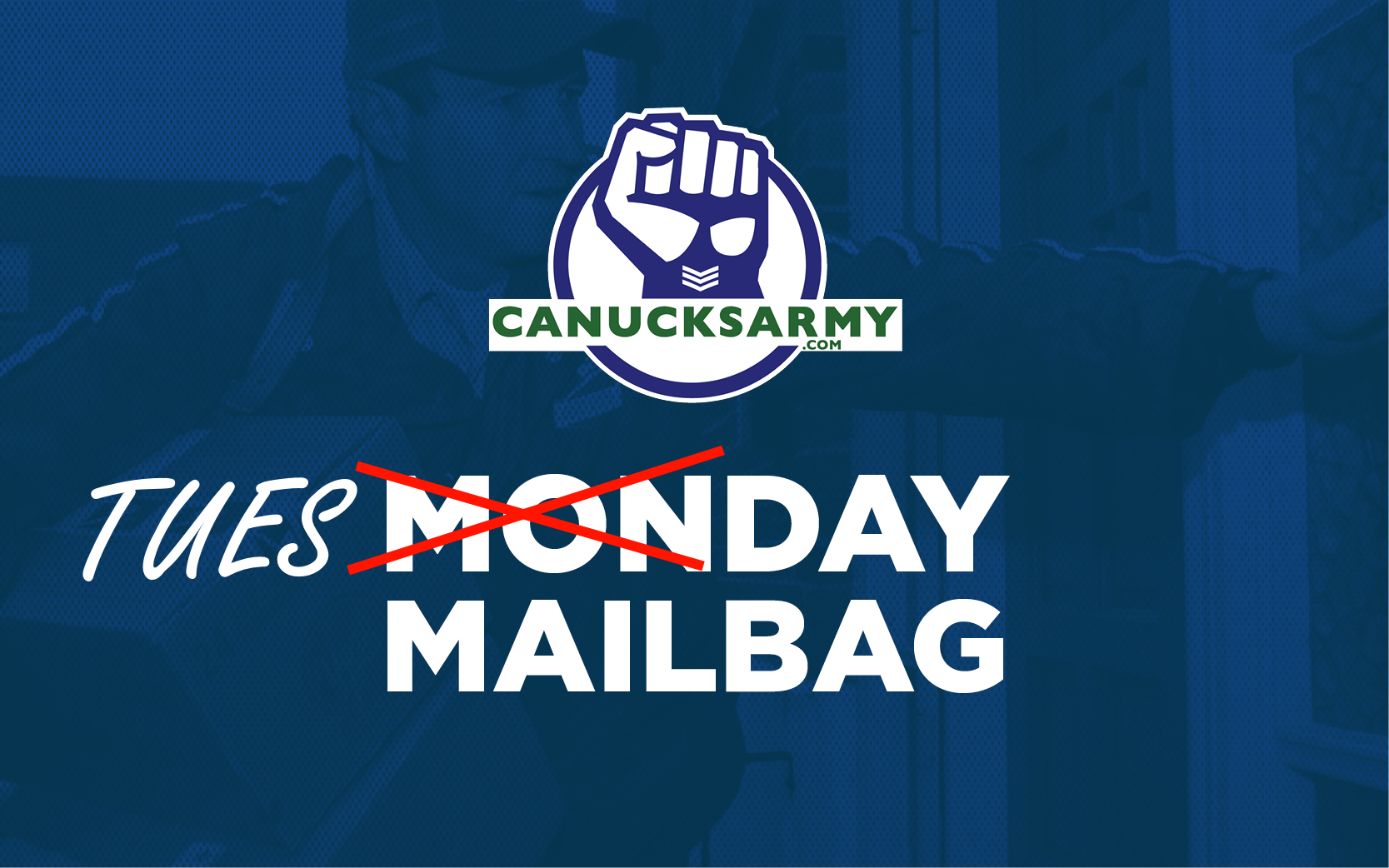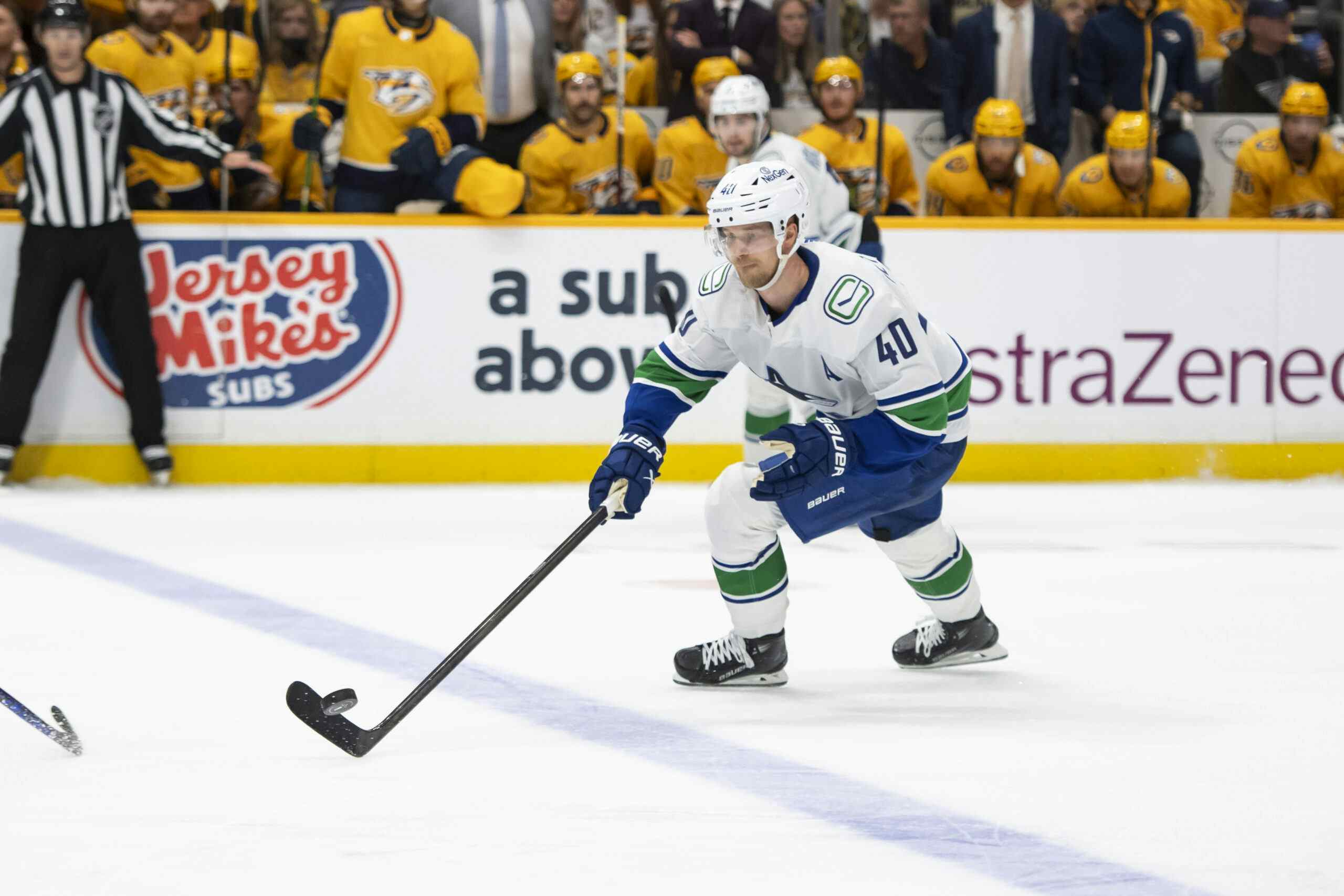Canucks 2013-14 Season Preview: Forwards

All images in this post courtesy wikimedia commons.
Meaningful(-ish) regular season hockey is almost here! The Canucks will open the 2013-14 NHL season on Thursday night in San Jose, so of course we’re kicking off our detailed Canucks season preview. We’re beginning today with a preview of Vancouver’s centre group, and we’ll roll through some predictable topics between now and Thursday (defense, goaltending, the new Pacific Division).
Let’s get to Vancouver’s forward group on the other side of the jump.
Overview

During the lockout-abbreviated 2013 season, the Vancouver Canucks’ forward group was incredibly shallow. For the first time in the Mike Gillis era, the Canucks were the definition of a one-line team.
With Ryan Kesler and David Booth out of the lineup for the majority of the 2013 season, Vancouver was impossibly reliant on the Sedin twins and Alex Burrows – both for offense, and for control of the game. You probably know from watching that it was a fire drill whenever Vancouver’s depth players were on the ice last season, but let’s waste some time quantifying that anyway. In score close situations in 2013 (so whenever the game was played at five-on-five while the score was within a goal) the Canucks outscored opponents by 19 with Henrik Sedin on the ice. Without the twins on the ice at even-strength with the result in doubt, the Canucks were pummelled and outscored by 5.
The Canucks jettisonned centermen Derek Roy and Maxim Lapierre in free-agency this offseason, and replaced them with Brad Richardson, Zac Dalpe and Mike Santorelli. All due respect to Richardson, Dalpe and Santorelli, but it seem probable that Vancouver’s "bottom-9 issues" could linger into this season.
Really the biggest change the Canucks made this offseason was behind the bench, with John Tortorella taking over for Alain Vigneault. Tortorella is a zone-matching coach like Vigneault was, so some forward deployments are likely to seem familiar to Vancouver’s group. But the coaching change will still have a significant impact on the responsibilities of Vancouver’s forwards in other areas.
In New York, for example, Tortorella generally played his top forwards more than Vigneault did when he was in Vancouver. Last season Rick Nash averaged a full minute more than Daniel Sedin did at even-strength on a per game basis. With the sleep doctors and the travel demands in Vancouver, that’s a trend we could well see reversed, but it’s certainly worth watching for.
I suspect the "Tortorella effect" will be felt (literally felt) most keenly by Canucks forwards in the realm of shot blocking. Tyler Dellow broke this down wonderfully last week, but Vancouver blocked a whole whack of shots by defenseman last season while executing Alain Vigneault’s system. The big difference between the Tortorella Rangers and the Vigneault Canucks was the number of shots by forwards that Tortorella’s Rangers blocked. The Canucks actually blocked a higher percentage of shots from defenseman.
The downside of Tortorella’s obsessive shot-blocking system is the potential for injuries. Expect to hear the term "meatwagon hockey" whenever another forward does down with a hairline fracture (as Jordan Schroeder did this preseason). The upside is that there may well be some "unseen value" (as Dellow described it) to what Tortorella preaches, as it appears to discourage forwards from shooting as often.
Beyond laying out and taking one for the team more often, Tortorella uses his top forward to kill penalties. Kesler did that anyway with Vigneault at the helm; but for the Sedin twins, spending a good deal of time at 4-on-5 this season will represent a significant change from the Vigneault-era.
Centremen

Henrik Sedin
Henrik Sedin had the best two-way season of his career last year. The Canucks captain started a higher percentage of his shifts 200 feet away from the opposition’s net, and spent more evenings chasing around the likes of Jonathan Toews, Anze Kopitar and Logan Couture. Not that any Eastern scribes noticed, but more often than not, Henrik came out ahead in those matchups.
Sedin’s production was below a point per game for the second straight season, and it’s unlikely that he’ll return to his Art Ross trophy levels of production at 33-years of age. At least not without some extremely favourable percentages.
But that won’t matter if Henrik can continue to drive play and on-ice shooting percentage against top-competition. The Canucks controlled 62% of all shot attempts with Henrik on the ice in score close situations last year, while shooting at a 10.4% clip. Those marks are probably unsustainable, but Henrik’s line should be able to manage somewhere in the high-50s and somewhere in the neighbourhood of 9% on-ice shooting. Henrik’s continued presence among the five best centreman in the world is the single main reason that those folks counting the Canucks out as a playoff team are dead wrong.
Ryan Kesler
Breaking: Ryan Kesler’s health and performance is critical for the Canucks this season. Also breaking: Ryan Kesler at some point this season.
Not to belabour this but Kesler "broke" into the league as a relentless checker who could drive play and be relatively productive in spite of a limited offensive skillset. Since then he’s spent years maniacally sharpening his wrist shot to make it the dangerous weapon that it is.
So it’s an odd twist for me to suggest this, but it’s possible that age and a myriad of injuries will catch up to Kesler, and begin to restrict his ability to control play and dominate games. It’s possible that could occur even as his offensive ability is now good enough to allow him to continue to fill up the stat sheet (this is basically what happened to Jarome Iginla in his early-thirties). In fact, it’s possible that process is already underway.
At his best, Ryan Kesler plays the game unencumbered by physical limitations. Anyone who has watched his career closely knows that he’ll be finishing checks with playoff ferocity in game fifty-something against the Calgary Flames come early February. He can’t even help himself.
But in 21 games last season (including the playoffs) Kesler’ offensive contributions served to obscure a dirty little secret: the Canucks were routinely buried when Kesler was on the ice.
Admittedly Kesler’s performance last season came in a small sample of games. And that performance was out of line with his career norms. It definitely might just be noise, or a short term atrophying of Kesler’s two-way skill as a result of injury.
Or maybe Ryan Kesler has reached a point in his career where he’s a good enough shooter to drive offense, but limited in his ability to drive play. I think the former possibilities are more likely, but not by much and unfortunately for the Canucks, it was Kesler’s ability to control play that has made him so valuable in the past.
If a summer of rest and exercise has served to restore Ryan Kesler to his previous form, then I’d expect him to get the brunt of the defensive responsibility from Tortorella. Outside of Henrik Sedin and Kesler, there just really doesn’t appear to be a credible "tough minutes" option on the roster. So Kesler may well draw that assignment.
Between age and the likelihood of his playing some very taxing minutes, Kesler’s days of scoring 30 goals and 70 points might be behind him. But if the aging two-way ace can return to his play driving ways, soak up tough assignments and defensive zone-starts, and add some offense (say 50 points?) the Canucks will be in much better shape than they were a year ago. As always: Kesler is the wild card for Vancouver.
Brad Richardson
When Brad Richardson was signed, and advertised as Vancouver’s possible third-line centre it seemed a bit odd. After all Richardson is a player who can only be described as a centre if you’re being very generous. The same goes for the third-liner tag.
Richardson has posted some very auspicious underlying numbers over the past several seasons, and even spent some time in Los Angeles’ top-six skating with Dustin Brown and Anze Kopitar. I’d suggest to you, however, that Richardson wasn’t exactly the straw that stirred the drink for the Los Angeles Kings.
Still, Richardson’s WOWYs look promising. Of the 13 skaters with whom Richardson has spent more than 200 even-strength minutes playing with since 2010-11, 10 of them did better (in terms of controlling attempted shots) with Richardson than they did without him. The other three were Drew Doughty, Anze Kopitar and Dustin Brown.
Richardson has also posted an impressive penalty differential, which is a good example of unseen value and usually an indicator that a player is able to outskate, out-battle or at least out-act the opposition with some regularity. Richardson has also been solidly productive offensively in the past, at least for a bottom-six player.
Add it all up and if Richardson is your fourth-line left wing and fifth option at centre, then you’re sitting pretty. In other words he’s a good fourth-line forward. But if he’s your third-line centre, well, you clearly have a problem.
Mike Santorelli
Mike Santorelli had a forty-point season in Florida three years ago, but expecting him to re-find that form is a bit much.
He’s 28-years old and a forward at the NHL fringes. He’s probably better suited to filling that Jeff Tambellini, Andrew Ebbett 7th scoring forward role than he is to replace Derek Roy (who replaced Jordan Schroeder, who replaced Samme Pahlson, who replaced Cody Hodgson, who replaced Maxim Lapierre, who replaced Manny Malhotra) as the clubs third-line centre. He might be forced into that role, however, as a result of injuries and sheer lack of depth.
Santorelli is at least a decent face-off man with some offensive pop, but there isn’t much else to recommend him. His underlying numbers are unspectacular and seven of the thirteen players with whom he’s spent at least 200 minutes at even-strength over the past three seasons did better without him (in terms of controlling attempted shots).
Santorelli had a very strong training camp. He reported fit, and he outperformed (or in Schreoder’s case out-healthed) his competition in the preseason. I’d imagine Santorelli will get a look on the club’s third-line with former linemate David Booth to begin the season. Whether he can grab that opportunity and run with it is anyones guess, but I’d bet against him being a medium-term answer to the club’s perpetual third-line centre question.
Jordan Schroeder
Schroeder, who spent the summer recovering from a shoulder injury, is out with a hairline fracture and won’t be in the lineup until late October at the earliest. When he returns it’ll be very interesting to see where he fits in on a John Tortorella team.
Vancouver’s first round pick in 2009, Schroeder was probably Vancouver’s best depth option at centre last season, which says more about the Canucks roster than it does about Schroeder. He came out ahead against relatively soft competition and he only did a bit better than his circumstances dictated. Certainly he wasn’t productive enough offensively in those minutes, even if some of that was percentage based.
Schreoder turned 23 this weekend, and he hasn’t scored enough at the NHL or AHL levels to suggest that he’s a future top-six forward in the league. While his defensive awareness is solid, and he has the chops to be a plus possession player, it’s very rare for 5,9 centremen to be considered for bottom-six jobs in the NHL.
Compounding the issue: Jordan Schroeder is waiver eligible this season. So if he’s not going to play in Vancouver, every team in the league will get a chance to claim him before he can be assigned to Utica.
So is Schroeder an NHL player? The underlying numbers suggest he is. But common sense suggests he’s probably not. In determining that question one way or the other, I’d imagine this season will be critical for Schroeder.
Zac Dalpe
Newly acquired forward Zac Dalpe has played at centre and on the wing at the NHL and AHL levels over the past few seasons. After a dynamite rookie season in the AHL, Dalpe’s prospect stock has come crashing down over the past few seasons as the Paris, Ontario native failed to earn a permanent NHL job with the Carolina Hurricanes.
With the Checkers last season Dalpe played second-line minutes and faced secondary competition. He was reasonably productive, but he certainly doesn’t look like a serious "tough minutes" option at this point in career.
In fact, generally speaking, Dalpe has been run over throughout his limited NHL time. This past season that changed a bit as Dalpe played in ten games with the Hurricanes and spent much of his time on a line with Jordan Staal. That line showed some promise and Dalpe posted some stellar underlying numbers (despite some cruel percentages).
If Dalpe has found another level, that’s great news for the Canucks. But it’s worth remembering that Dalpe was playing on the wing, and alongside one of the league’s better two-way forwards throughout last season. The Canucks will be moving him back to centre, and whle Dalpe may play with a solid play-driving winger like David Booth or Chris Higgins, he’s a long-shot to provide even average production as a third-line centre.
Still, Dalpe’s a legitimate prospect I think, so to acquire him for a song was a neat trick from the Canucks front office. Maybe not quite as neat as finding an everyday NHL third-line centre. But… Yeah I have nothing.
Left Wing

Daniel Sedin
Daniel Sedin is aware that he had an off-season last year, and he’s aware of the impact shooting percentage had on his production. Daniel’s a smart guy it seems, even if his expectations (he says he won’t be satisfied with a 30 goal season) remain a bit high.
The good news is that Daniel’s shot rate increased in 2013 from where it was in 2011-12, even though he started less often in the offensive end of the rink and was matched up against stiffer competition. The percentages will probably regress in the former Art Ross trophy winner’s favour, but as the 33-year-old winger gets longer in the tooth, it’s probable that he’ll begin to incur some diminishing returns in terms of his overall utility and offensive production.
With Daniel taking on increased penalty-killing responsibility this season and with no credible "enabler" present on the roster to create easier circumstances for Vancouver’s top-line, it seems unlikey that Daniel will manage to produce at a point-per game rate this season. But Daniel remains one of the better two-way left wingers in the NHL, and with Henrik feeding him the puck 30+ goals and 70+ points seems reasonable if he can stay healthy.
David Booth
It’s a bonafide miracle that David Booth will be in Vancouver’s opening night lineup. The real life sharpshooter and on-ice shooting percentage drag only managed 12 games last season, and missed 20 games the year before. Booth’s inability to stay in the lineup has been far more damaging to the Canucks than his inability to beat goaltenders, frankly.
Booth remains an elite ice-tilting forward, and that’s a very rare skill for a winger to possess. If he’s healthy he can help an otherwise unimpressive line hit 55%+ control of attempted shots, and that could be especially useful if Kesler’s days as a play-driving force are behind him.
Consider that last season the Canucks controlled 62.9% of shot attempts with David Booth on the ice in score close situations. That’s impressive on it’s own, but it’s a herculean accomplishment when you remember that his most frequent linemates were Maxim Lapierre and Zack Kassian. Yeah the Canucks were outscored five-to-one with Booth on the ice at evens and the result in doubt, but that was mostly bad luck. The point is: regardless of what offense he can provide, Booth’s neutral zone play and ability to win puck battles still has significant value.
If he’s healthy. But that’s a huge if at this point. It’ll be important for Booth personally to stay in the Canucks lineup this season, but if he can’t, then it’ll be important for the Canucks that Booth is healthy during the compliance buyout window this summer…
Chris Higgins
Chris Higgins enters the first season of his four-year, $10 million contract extension this season. It’s a deal that carries some risk when you consider Higgins’ age, and the way his underlying numbers plummeted last season.
The hope for Vancouver is that Higgins was simply tasked with too much responsibility last season. In 2013 Higgins played often on a line with no real center and heaps of defensive responsibility. In the past Higgins has been a puck-winning machine and a fine puck possession player, and the Canucks will need him to show that form again this season (and for three subsequent seasons).
If Kesler bounces back this season, Higgins could be a useful wingman on a swashbuckling line that Tortorella is sure to grow fond of. If that cheery scenario doesn’t play out, however, Higgins may spend an awful lot of time the way he did last year: playing defense in the Canucks end of the rink.
Tom Sestito
Tom Sestito was picked up off of waviers last season and he fought a bit, played some below average hockey and mocked Nail Yakupov once. Sestito is big and has some skill but he’s generally not quick enough to be a punishing hitter, and Tortorella called out his fitness level this preseason.
Basically Sestito won’t play much for Vancouver this season, and may end up as waiver fodder.
Jeremy Welsh
Jeremy Welsh was productive in college, but his offensive game hasn’t translated at the professional level. The Canucks acquired him as the cost of doing business in the Zac Dalpe trade, and Welsh is expected to start the season in Utica. I haven’t seen him play much and Welsh doesn’t have much of an NHL track record to analyze, but one could imagine that he may be a modest upgrade on Sestito.
Working in Sestito’s favour, however, is his lower cap-hit and the fact that Jeremy Welsh is ineligible for waivers, while Sestito would have to be exposed were the Canucks to return him to his hometown Comets.
Right Wing

Alex Burrows
Alex Burrows has been one of the leagues most reliable even-strength goal producers over the past five seasons. Obviously he’s the beneficiary of playing with some excellent players in the Sedin twins, but he’s demonstrably made them better for the most part.
Last season Burrows’ offensive production slipped pretty significantly. Some of that was lady fortuna and her devilish percentages, and some of that was the way Burrows was used as a "Mr. Fixit" by Vigneault. Whenever Vigneault needed to shore up one of Vancouver’s unimpressive depth forward lines, he’d drop Burrows down the lineup to drag the rope. At one point in the season Burrows scored a lovely game winning goal while skating on a line with Andrew Ebbett and an out of position Keith Ballard. That actually happened.
Burrows was expected to start the season with Ryan Kesler, while Zack Kassian rode shotgun with the Sedin twins. That plan never made sense to me, frankly, and the Canucks may have got a bit lucky that Kassian’s suspension threw a wrench in that design. Burrows with the twins has been one of the best lines in hockey over the past five seasons, and the Canucks incur a marginal opportunity cost whenever they push Burrows done the lineup. As Handel well knew: if it ain’t Baroque, don’t fix it.
However else Tortorella chooses to use his forwards, Burrows should be a staple in Vancouver’s top-six and on their penalty-kill. He should almost never, at this point, spend time on the power-play however.
Jannik Hansen
Jannik Hansen signed a 4-year, $10 million contract extension this week and it was well earned. The Danish winger has proven himself to be a very useful defensive player, and a sneaky productive offensive presence as well.
Hansen has consistently placed among Vancouver’s most efficient point-producers. He manages to be productive utilizing his speed, his forechecking ability, his very under-rated playmaking ability and his high-velocity slapshot (which, he really began to fall in love with last season).
Ideally, I’d imagine the Canucks would prefer to use Hansen with Booth and one of Richardson, Santorelli, Schroeder or Dalpe on a quick third-line that can hold the puck in the offensive end while the Sedins and Kesler take a breather. He’s well suited for that, but he’s also the second best candidate to play with the Sedin twins (who’ve actually scored more efficiently with Hansen than with Burrows) and a very credible top-six winger at this point in his career.
Zack Kassian
It’s tough to know what the Canucks have in Kassian. Kassian’s offensive instincts are solid, his skillset is occassionally dazzling, and he’s not reluctant to use his size to protect the puck. Kassian has improved over the past two years – with his fitness level and defensive awareness taking a big step forward since he was first acquired in the Cody Hodgson deal – but his overall consistency and discipline just isn’t there at this point.
Kassian was all set to begin the season as the designated triggerman and protector of the Sedin twins on Vancouver’s top-line, but a slash to Sam Gagner’s mouth resulted in a broken jaw for the Oilers centre and a long suspension for Vancouver’s wannabe power forward.
The young, toolsy forward still has room to grow and a bit of time to figure it out. But as each season goes by without Kassian establishing himself as a useful top-nine forward, he begins to look more and more like a slightly better and significantly meaner version of Steve Bernier. There’s some value in that, admittedly, but it’s not what the Canucks were hoping for when they acquired Kassian back in 2012.
Dale Weise
Dale Weise is a safe, reasonably useful fourth-line forward with solid wheels. He’s not the most popular player among Canucks fans and he’s not the most intimidating fighter, but he’s probably Vancouver’s best fourth-line forward at this point.
I’m curious to see how Tortorella and Weise, who was in the Rangers organization until the Canucks claimed him off of waivers in the fall of 2011, co-exist. Weise has often been criticized for trying to play an east-west game despite his north-south job description. Will that pass muster with Tortorella behind the Canucks bench?
Recent articles from Thomas Drance





